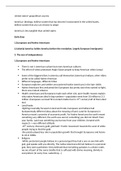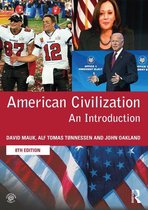United states= geopolitical country
America= ideology, believe system that has become incorporated in the united states,
believe system that you can choose to adopt
America is less tangible than united states
Early days
1.Europeans and Native Americans
2.Colonial America (white America before the revolution, largely European immigrants)
3. The war of independence
1.Europeans and Native Americans
There is not 1 American culture but more American cultures
The effort of white protestant Anglo-Saxon people to keep American white (wasp)
Some of the biggest tribes in America call themselves (American) Indians, other tribes
prefer to be called Native American
Different languages, different tribes
European explorers and settlers encountered Native Americans in the late 1400s
Native Americans first welcomed the Europeans but pretty soon they started to fight,
there was mutual violence
Health: Americans and Europeans made each other sick, pure health reasons explain
why native Americans died in big numbers-> population went from 10 million to 2-3
million. (Europeans survived first contacts better but in 17th century half of them died
too)
Land/trade:
-fighting invariably focused on land and trade, Europeans and Indians had
fundamentally different ideas about the meaning of land. Land for Europeans in
America meant a promise of economic profit. For Native Americans the earth meant
something very different, the earth was sacred, something you did not inherit from
your family. Land was something you borrow from your children. (treated with
respect) -> very different attitude
-19th century: discovery gold, goldrush= frantic movement towards the west of white
people trying to find the gold.
-the potato played key role in population growth that brought Europeans and Asians
to US in 1800s.
Religion:
-White protestant people believe in a personal god they had a one on one link with
god, god speaks with you directly, The native Americans did not believe in a personal
god, they were pantheists= they believed that everything partakes in a divine order,
we are all part of the same totality that is suffused with divine meaning, divinity is
everywhere (in every tree, waterdrop,…)
, -Protestants were individualists, Native Americans thought fundamentally in
communal terms, they had no sense of a strong individual as a strong subject
Painting= the people in the painting are sitting on the edge of a cliff at the western
most edge of the country (California) -> the development of America is an East-West
story , it’s a westward story, The native American population is being pushed of the
cliff, to the western edge
Founders= settles who established the colonies.
The Spanish occupied: coastal Florida, Southwest, California (1500s-1600s)
The French traded along north America’s inland rivers
The English established their first permanent settlement at Jamestown, Virginia in
1607.
Indian Reservation system dates back to 1630s and 1640s:
1830 Indian Removal act= Federal policy required the removal of all remaining tribes
to a permanent Indian territory.
o Many tribes north of the Ohio River had already signed individual removal
treaties before this and we're living in parts of present-day Kansas, now all
the other southern tribes were moving to Oklahoma except for two tribes the
Seminoles and the Cherokees. -> this caused the trail of tears.
Trail of tears: forced march of the Indian tribes (Cherokees) who were forced to leave
their land to walk for days, weeks to go to the state of Oklahoma which was designed
to be an Indian state.
o -> Before this trail the Cherokees had appealed to US federal court to fight
the removal plans and Georgia's seizure of their lands:
the Supreme Court ruling this case (Cherokee Nation V Georgia 1831) called a
Native American tribe neither an independent nation nor a state but
“a domestic dependent nation” = Tribal lands are outside American political
structures by right of first residence Native Americans had sovereignty over
their lands and could only lose them voluntarily and with just compensation.
State laws did not apply to them where native laws took priority American
citizens could not enter Native American lands except by permission or treaty
right.
-> therefore, the Supreme Court decided and declared the removal act and
George's actions illegal. BUT president Jackson and Georgia ignored this still
moved = trail of tears.
1890 Wounded Knee: name of a place where white people killed of hundreds of
Indians at night (even women and children)
2. Colonial America
St. Augustin, Florida: the myth of America does not really start in Florida but
Jamestown, Virginia (1607) : starts here
1619: First African laborers as indentured servants: deal with white people: you pay for my
passage to America then I will work for you for free until I have paid back the cost of my
transportation -> difference with slave, indentured servants decide
They worked mainly on tobacco plantations
,1620: Pilgrims (separatists, Mayflower)
General misunderstanding about beginning of America: the ship Mayflower that brought the
puritans to America
-> But the pilgrims were protestant separatists, they were disappointed with the way religion
was organized in Europe, the wanted to start all over again in the new world, they had no
intention of ever returning to Europe. This experiment didn’t go anywhere, but 10 years
later different protestants arrived on the Arbella and these protestants were called puritans
(1630), they were reformers they came to the new world to create a religious utopia to serve
as an example to the old world, they saw it as their mission to set an example for the new
world
=idea that the world has to be saved by Americans, believe that they have to show how a
Christian culture works
- on Arbela was a priest named John Winthrop he supposedly abort the Arbela while they
were crossing the ocean he hold a sermon, addressed to the puritans and said don’t start
dreaming, this new society is going to be just like England, a farrow class society, don’t think
we are going to create an equal society (not democratic)
- puritans were reformers not separatist and their experiment did take off, they survived the
first generation, historically they were much more important than the Mayflower people
-their society was characterized by rich and poor people, so the American dream was not
there when the American story started-> All men were created unequal
Face to face society= America was backwater of white society; the largest city back then was
Philadelphia (there were only 20.000)
-> England was much more industrialized, there were only small cities, everybody knew
everybody else (face to face society)
You were also largely dependent on your neighbors and other people in you community
In terms of social reputation
Defamation= terrible crime, if your good name had been compromised by somebody else
you took them to court because your name was very important if you wanted to survive,
defamation cases were one of the most common court cases in the early ages.
Friendship= larger networks of people who were all dependent on each other, it’s not a term
of intimacy but of interdependency
Husbandry= husband was a word used for a farmer, you still have the verb to husband in
English, means how to use means, how to use means effectively, wisely
Book accounts= the listing of all the relationships between people that will create some kind
of cohesion
Proprietary wealth= how did rich people become rich and stay rich, land was cheap once so
you own land you could keep it or rent it.
Patronage= The entire society in 18th century in America was run on a family model, political
leadership was discussed in political terms
, Americans had no idea of the importance of structures in a society, (they did not think in
terms of society as a huge web of structures and relations that were anonymous, they
always thought someone was responsible) they had a very simplistic rural society
Native Americans (boek)
American cultures were more eager to want things
First there was a short period of relative peace: settlers exchange technology for land
first and knowledge of the Native Americans survival techniques.
then conflicts caused by trade disagreements expanded white settlement and
cultural misunderstanding escalated into a war.
In 1620s and 1630s The Native Americans tried by war to expel the intruders and
threatened the existence of the Virginia and New England colonies.
During third phase white military defeated the natives.
In 18th century Britain and France competed for power in North America. Both vied
for native allies. The French generally 1 support from more tribes because they
seemed less threatening. The British government introduced because of this a new
policy during French and Indian war (18th century) which gave gifts at native leaders
and set a western limit to colonial settlement. -> the French ended up losing
Proclamation of 1763= a line west of Appalachian Mountains was official boundary
Treaty of 1783= Britain ceded to EU S all the land between Canada and Florida to the
Mississippi River and asked no protection for Native American rights.
Congress sent missionaries to transform natives into farmers.
Meanwhile the population West's off the Appalachians was growing rapidly and
between 1800 and 1810 the Shawnee leaders Tecumseh and The Prophet worked to
form an alliance of tribes east of the Mississippi to limit US expansion.
But while Tecumseh was lobbying for support among southern tribes Americans
defeated his forces in the north.
He joined the British against the USA in the War of 1812 and died in battle. This led
many tribes to move further West after the war.
Americanization took 3 forms:
o Deliberate eroding (ondermijning) of tribes’ legal authority: in 1870/80s
congress removed local control and replaced tribal rule with federal or state
law. They also gave US citizenship to natives which gave them rights they
could defend in court and made them responsible to also follow state and
federal law.
o Educating Native American children at boarding schools. This was far away
from the reservations and broke all ties with tribal culture.
o Allotment programs= Dissolving reservations into small farms owned by
individual Native American families. Dawes act 1887 makes this US policy.
Tribal restoration and termination 1934-1970:
o 1930s: Allotment was the cause of extreme poverty, poor health and low
educational levels of N A.





